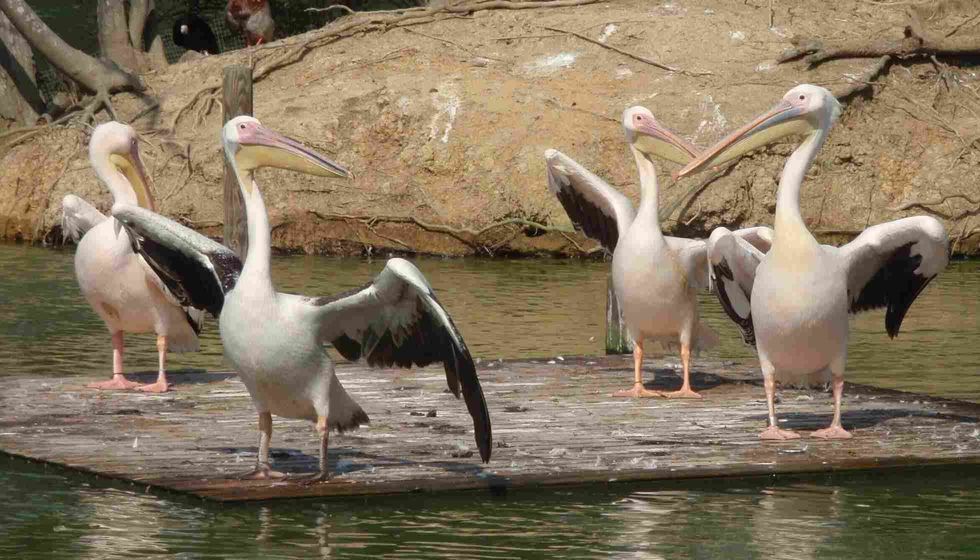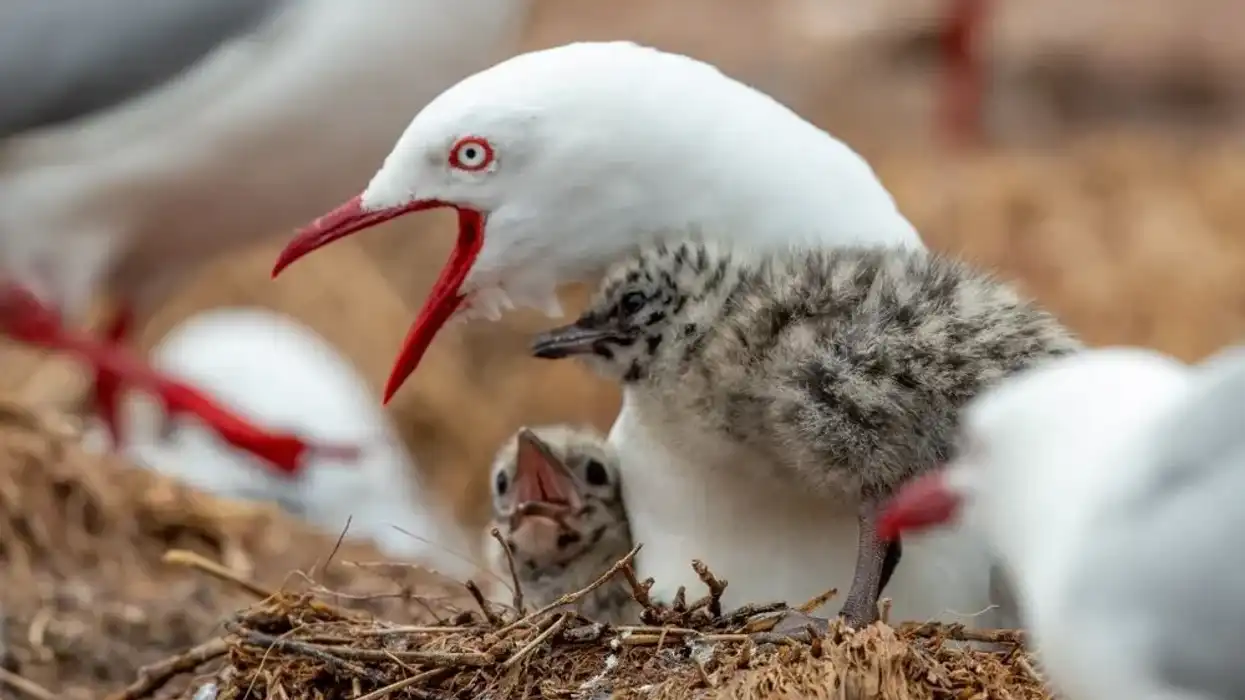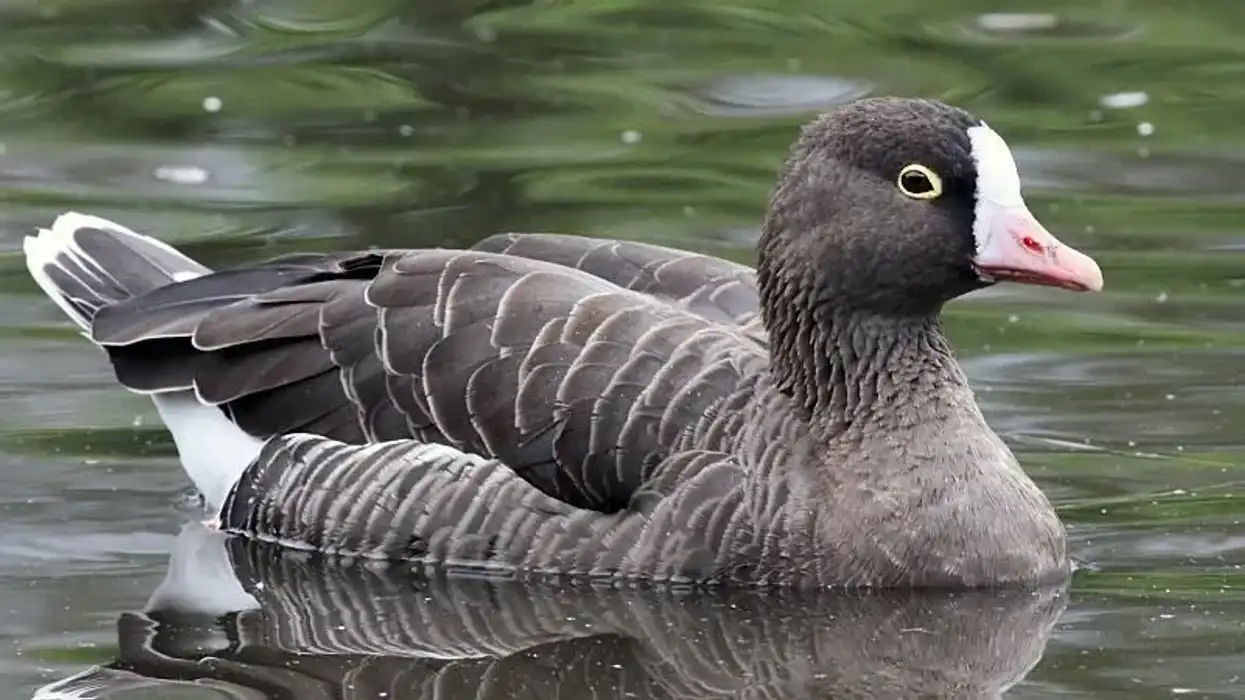The Great White Pelican (Pelecanus onocrotalus), also known as the white pelican, eastern white pelican, or rosy pelican, is a pelican-like bird. The Great White Pelican breeds in Asia and Southern Europe.
The Great White Pelican has no subspecies. Great White Pelicans are also referred to as white pelicans or eastern white pelicans.
The most distinctive feature of the Great White Pelican (Pelecanus onocrotalus) is the large bill which is used for creating a large pouch to catch fish and other aquatic animals.
When the pelican pushes its bill under the water, the lower bill blows out, creating a large pouch to catch water and fish. When the Great White Pelican lifts its head, this pouch contracts, thereby forcing out the water but retaining the fish.
This species is also known as the white pelican and the eastern white pelican as well. Here are some of the most interesting facts about the Great White Pelican (Pelecanus onocrotalus) for your knowledge. Afterward, do check our other articles on the Australian pelican and Dalmatian pelican as well.
Great White Pelican Interesting Facts
What type of animal is a Great White Pelican?
The Great White Pelican (Pelecanus onocrotalus) is one of the world's largest flying birds, inhabiting swamps, marshes, and deltas of Africa, Asia, and Eastern Europe.
What class of animal does a Great White Pelican belong to?
The Great White Pelican bird is a bird in the Pelican family and comes under the avian class of birds. The nest for these birds can be found across freshwater lakes, marshes, swamps, shallow lakes, or islands in their natural habitat.
How many Great White Pelicans are there in the world?
According to the IUCN Red List, the world population is estimated to be 265,000-295,000 birds. According to Wikipedia, Europe presently contains around 7,345–10,000 breeding pairs, including over 4,000 nesting pairs in Russia.
Over 75,000 birds have been sighted in Israel during migration, while over 45,000 birds may stay in Pakistan throughout the winter. In Africa, it is expected that 75,000 pairs nest.
Where does a Great White Pelican live?
The Great White Pelican, which dwells in Africa's shallow swamps, is one of the world's biggest flying birds. They occasionally perch in trees, but they mainly roost on the ground. Due to the continuous loss of foraging grounds, Great White Pelicans have been forced to fly long distances to look for food.
What is a Great White Pelican's habitat?
Large flocks may cluster in traditional roosts, which are also utilized as daytime resting spots after fishing trips. They occasionally perch in trees, but they mainly roost on the ground.
Fishing is generally over by 8-9 a.m., and they spend the rest of the day relaxing, preening, and bathing on tiny islands or sandbars. They bathe by submerging their heads and bodies in water and fluttering their wings. When they are overheated, they will expand their wings or gape to cool off.
Who do Great White Pelicans live with?
Great White Pelicans live as a flock of birds in large colonies. Great White Pelican migration also takes place in the form of groups. In the temperate zones, their breeding season commences around May but in Africa, the breeding continues for a large part of the year in the breeding sites across Africa.
How long does a Great White Pelican live?
These powerful fliers can live up to the age of 51 years, provided they remain in the defined Great White Pelican range.
How do they reproduce?
Monogamous Great White Pelicans develop long-term pair connections. A couple will construct a nest from sticks on the ground or in a tree.
They usually nest in groups around small lakes, bogs, or on islands. Two eggs are typically deposited in the nest as a clutch, and the female incubates them for 31 days, after which the young pelicans are born.
What is their conservation status?
The Great White Pelican is listed as a species of Least Concern in terms of its conservation status, though this species is declining marginally in Europe (Danube Delta) as a result of human activities. There is a sizable African community of nearly 75,000 pairs.
Pelecanidae has one genus, seven species, and 12 taxa. While two species are endangered, none have been extinct since the early 17th century. Except for Antarctica, the family can be found on any continent.
Great White Pelican Fun Facts
What do Great White Pelicans look like?
Great White Pelicans' primary feathers are gray and black. Pelican bodies look enormous, and they have long, broad wings that are linked to them. Their tail is small and pinkish, and their legs and feet are webbed.
Their eyes are surrounded by a bare pink/yellowface area. Their wonderful bills are azure blue on high and yellow underneath, wherever an oversized pouch is also found.
The bill is also red, with a central line that terminates in an exceedingly skinny red hook. The Great White Pelican's breast and throat will be pink or yellowish/orange looking in the coupling season. The male has rosy skin on his face, whereas the feminine has orange/yellow skin.
How cute are they?
They look so cute and appealing to the eyes especially when they are in groups.
How do they communicate?
Great White Pelicans are generally silent except in the breeding season when the adults make low, hoarse display calls. To defend their territory, a male warns intruders by gaping, clapping his bill, bowing, and, if necessary, fighting with his bill.
How big is a Great White Pelican?
The average range of length for a Great White Pelican is 55-71 in (39.7-180.4 cm). The Great White Pelican's wingspan is extremely impressive at around 7.5-11.8 ft (228.6-359.6 cm).
How fast can a Great White Pelican fly?
A Great White Pelican can fly at a speed of around 40 mph (64.3 kph).
How much does a Great White Pelican weigh?
The Great White Pelican's range of weight is between 20-22 lb (9.07-9.97 kg).
What are the male and female names of the species?
There is no specific name for the male and female names of the Great White Pelican. They are known as male Great White Pelican and female Great White Pelican respectively.
What would you call a baby Great White Pelican?
There is no specific name for the baby Great White Pelican, they are simply called young Great White Pelican.
What do they eat?
Great White Pelicans are carnivores (piscivores). These breeding birds consume fish, primarily cichlids, and carp, as well as tiny invertebrates.
Are they dangerous?
Pelicans may pose a threat to humans by their sheer ferocity. A pelican, after all, is a goofy-looking creature with an enormous mouth. This mouth is now mostly used for scooping up food.
Would they make a good pet?
No, these majestic birds are migratory and are not meant to be caged. They thrive and survive well only in their natural habitat.
Did you know...
Instead of diving to catch its meal, a Great White Pelican drops its head in sync with other birds to scoop fish into its massive throat pouch. When the Pelican pushes its bill under the water, the lower bill blows out, creating a large pouch to catch water and fish.
Pelicans are members of the Pelecaniformes family, and they are distinguishable from other birds by the fact that all four of their toes are webbed, a condition known as totipalmate.
The yellow gular pouch of this bird can hold 2.9 gal (13 l) of fluids or up to 8.8 lb (4 kg) of fish.
Great White Pelicans are extremely rare birds and bird watchers from across the world flock to Cape Canaveral to catch a glimpse of these rare birds.
The Great White Pelican's Migration
During the breeding season, migratory populations can be found from Eastern Europe to Kazakhstan. More than half of all Eurasian Great White Pelicans breed in Romania's Danube Delta. These birds also like Lakes near Burgas, Bulgaria, and Srebarna Lake in Bulgaria.
Past And Present Of The Great White Pelican
Raj et al. (2010) produced a compiled checklist of birds in the Pallikaranai wetlands, but they did not see the White Pelican during their study time (February–August 2010).
The Vedanthangal Bird Sanctuary, located near the Pallikaranai marsh in Tamil Nadu, is yet another significant breeding site for a variety of wetland bird species. Nonetheless, the Great White Pelican was never seen during an extensive survey in this region between 2007-2010 (Jayakumar 2013).
The Great White Pelican began visiting the wetlands in and around Chennai and Chengalpattu in recent years (since 2011). They were all around 30-40 years when they migrated to these areas.
Here at Kidadl, we have carefully created lots of interesting family-friendly animal facts for everyone to discover! Learn more about some other birds from our stork fun facts, and Atlantic Puffin facts pages.
You can even occupy yourself at home by coloring in one of our free printable pelican coloring pages.










